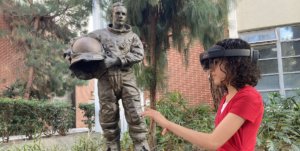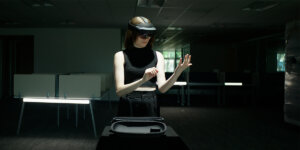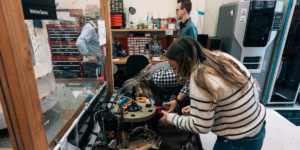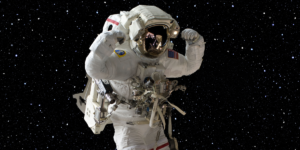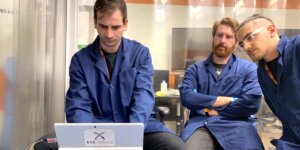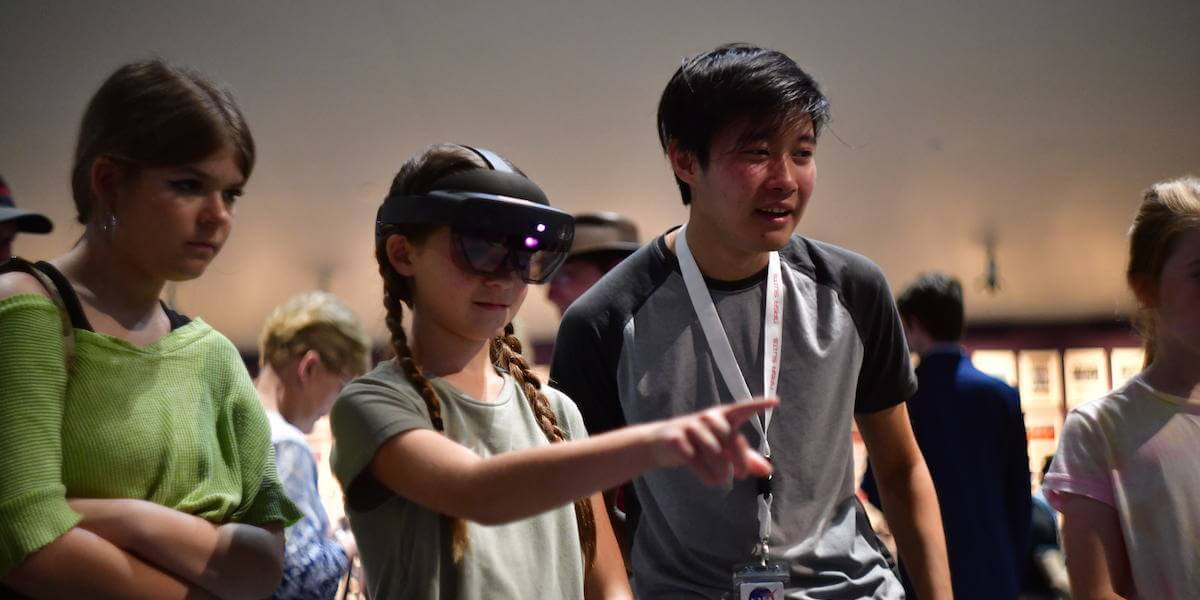
Lead Developer Spencer Lin oversees a visitor to Space Center Houston as they test out the S.E.N.V.A. application. PHOTO/TEAM AEGIS.
A virtual environment can be used to explore anything from a Costa Rican rainforest to a proposed new school building. Now a new NASA program is hoping to apply augmented reality (AR) to the exploration of space – with the help of some students. A recent challenge issued by NASA’s Spacesuit User Interface Technologies for Students (SUITS), launched in 2017, tasked students with designing and creating spacesuit information displays that share vitals, location and more within augmented reality environments.
USC’s and University of Arizona’s “Team Aegis” was one of 10 finalists in the SUITS challenge. Their display uses the Microsoft HoloLens 2 platform, a hands-free holographic device, and would host AR applications through the Unity game engine. For an astronaut exploring the moon, the user-friendly interface would share crucial information such as location tracking of the astronaut and rover, and vitals such as heart rate and oxygen levels.
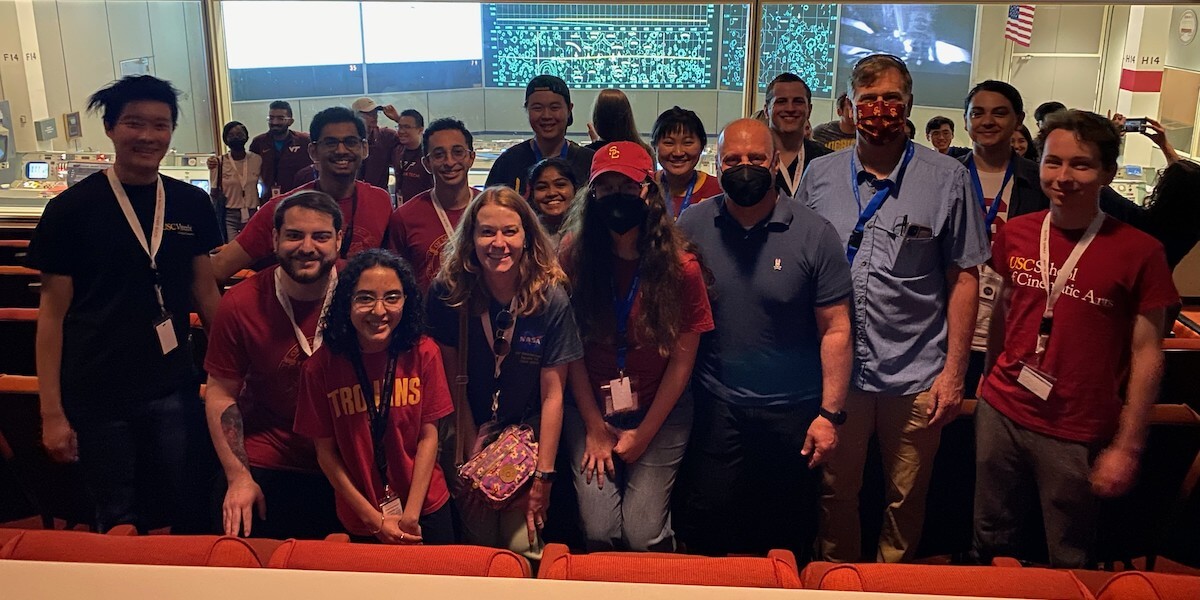
Team Aegis and its advisors in the VIP section overlooking the original control room for the Apollo missions at Johnson Space Center in Houston, Texas. First row (left to right): Andy Artze, Sophia Aguilar, Zoë Wilbur, Darlene Villicaña, Dr. Garrett Reisman, Professor David Barnhart, Will Farhat
Second row: Spencer Lin, Rohan Shukla, Bas Rizk, Stanley Lin, Akshita Swaminathan, Jennifer Lee, Evan Cooper, Isaac Ward
PHOTO/TEAM AEGIS.
The final SUITS event took place at the end of May at the historic NASA Johnson Space Center Rock Yard in Houston, Texas. NASA leads evaluated how well student technologies met key problems in the space, which replicates lunar conditions. Students not only got to test their designs, but they were also able to visit laboratories at the Space Center.
Said Evan Cooper, a USC Viterbi master’s student in the Department of Astronautical Engineering and project lead: “The weekend was absolutely amazing. Being able to test our design in the exact place where NASA is testing the technology that will take humanity to the moon and beyond is humbling. While the competition itself was the culmination of a year’s worth of efforts, it was far more rewarding to me to see the effect it had on our team. From visiting the Neutral Buoyancy Lab, a test facility filled with a massive pool that astronauts train for microgravity in, to standing next to the Saturn V, to being able to hear from industry leaders, the word I heard the most was ‘surreal’.”
Founded by Darlene Villicaña, a USC visual anthropology master’s student researching extravehicular interfaces, Team Aegis began as a group of 11 students. In December 2021, after its proposal was accepted by the NASA SUITS program, the team grew quickly to over 60 students from multiple disciplines and experience levels. Advised by USC Viterbi Professors David Barnhart and Garrett Reisman — as well as University of Arizona Assistant Professor Jessica Barnes — the students created an ambitious set of goals, a schedule and smaller teams that could work together to meet milestones.
The final test tasked teams with accurately guiding the user in real-time between multiple planned and unplanned locations, assisting crew members with navigation and visualization and interacting with the designated suit telemetry stream. Teams also had to include a user-friendly interface displaying all necessary information to crew members.
“There was no real ‘winner,’ but the output from the NASA lead and engineering team is that our group hit every one of the key problems and challenges very well,” Barnhart said. “NASA leads highly recommended we submit an application for next year’s challenge.”
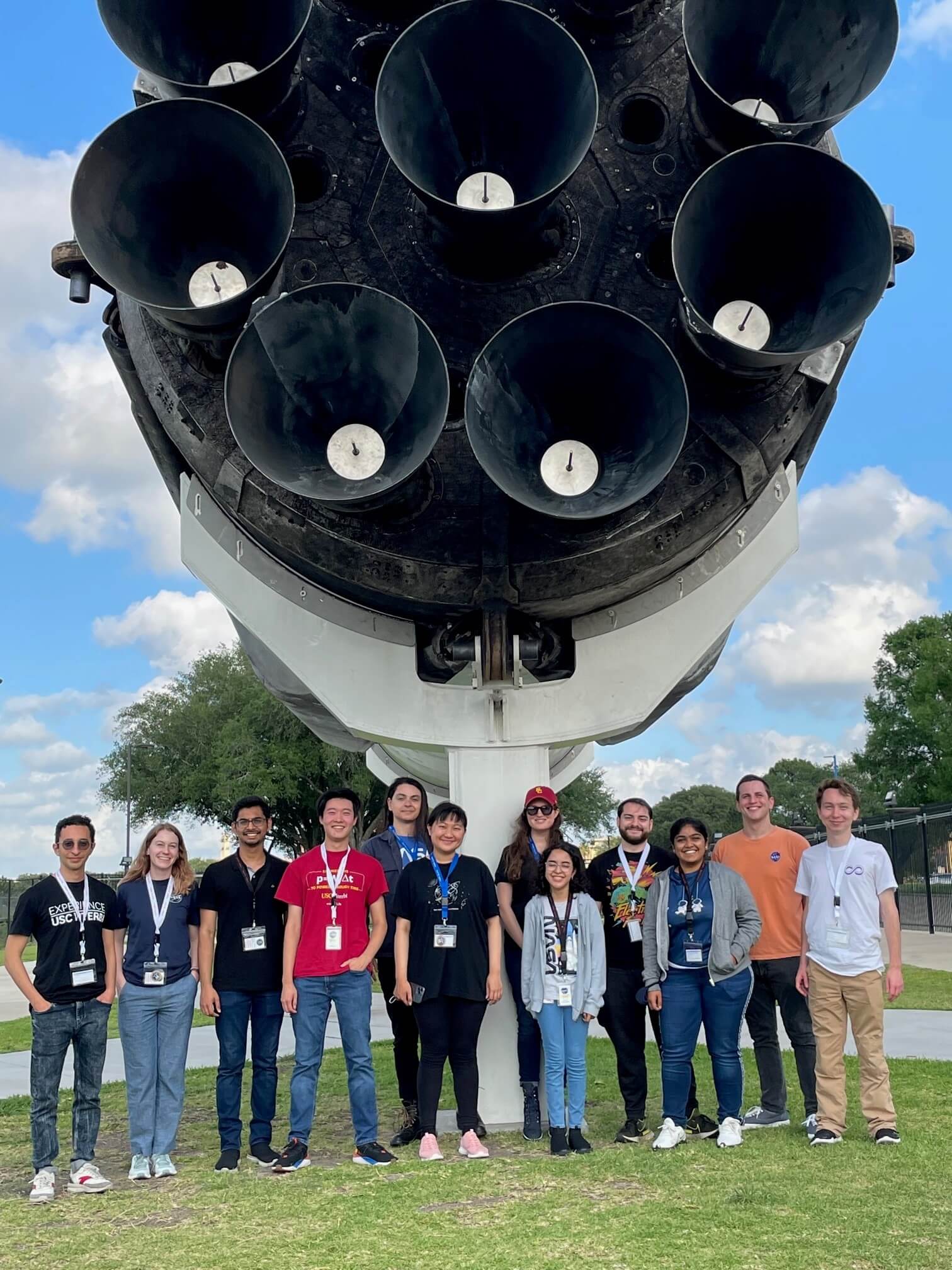
Team Aegis stands underneath one of the only two Falcon 9 boosters on display in the world. PHOTO/DAVID BARNHART.
Said Villicaña, “Our team approached the challenge from a cross-disciplinary standpoint. We have a team of passionate students from astronautical engineering, computer science, geology, and anthropology who creatively applied different methodologies to tackle the engineering problem.”
The interdisciplinary nature of the challenge, and the ability to translate core concepts learned in classrooms to hands-on experience makes it a valuable learning tool for students engaged in space engineering. So much so that Barnhart hopes to translate the experience into a class in the fall and allow more students to interact and prepare for next spring’s challenge.
Garrett Reisman, a former NASA astronaut, said, “Our USC/Arizona team did a great job and learned some very important real-world engineering lessons. Plus we had the best sizzle-reel video. I think this was a very valuable experience for our students and I certainly hope we do it again next year.”
The challenge comes ahead of Artemis, NASA’s mission to land American astronauts on the Moon. To support this goal, it will be essential that crewmembers are equipped with the appropriate human-autonomy enabling technologies that offer vital real-time information.
“NASA SUITS was a unique and invaluable experience that afforded us the opportunity to engage with a real engineering problem, to work with experts at the top in their fields who are actively working on these problems and technologies, and provided access to NASA’s planetary analog testing site and the ability to work on future technologies that are part of NASA’s Artemis program to develop augmented reality in spacesuit design,” Villicaña said. “We learned new skills, encouraged young minds to pursue STEM through our outreach activities, worked within a cross-disciplinary team, and made lifelong career connections and friendships.”
The Aegis team received support from USC Viterbi, the California Space Grant Consortium and the Arizona Space Grant Consortium.
The full team, from USC and University of Arizona, includes: Evan Cooper (Project Lead), Darlene Villicana (Deputy Project Lead, HITL & User Study Lead), Spencer Lin (Lead Developer, UI/UX Lead), Andres Artze (Systems Engineering Lead), Basem Ibrahim Mikhail Rizk (Machine Learning Lead), Isaac Ward (Terrain Meshing Co-Lead), Will Farhat (Terrain Meshing Co-Lead), Jennifer Lee (Navigation Co-Lead), Sophia Aguilar (Navigation Co-Lead), Akshita Swaminathan (Telemetry Co-Lead), Rohan Shukla (Telemetry Co-Lead), Zoe Wilbur (Geology Co-Lead), Patrick O’Brien (Geology Co-Lead), Stanley Lin (Marketing Lead), Aaron Shields, Aman Mohandas, Anand Shah, Andy Semin Park, Ann Tian Shao, Anunay Rajesh Bagga, Benran Zhang, Chandini Velilani, Christian Bryan, Dongzhe Wei, Elizabeth Lee, Ethan Ma, Felix Chen, Gabrielle Jung, Han Yue Emerald Liu, Ho Ko, Jason Chen, Jorge Gonzalez, Joshua Lac, Kamel Gazzaz, Kanika Jindal, Karim Rahal, Kasturi Khatun, Mansi Kulhari, Miru Jun, Nawach Kuptimanus, Ning Nie , Pavan Garidipuri, Phuong Pham, Smit Kadvani , Sofian Ghazali, Surya Roshan Mugada, Talha Rafique, Trinity Lopez, Yaxi Liu, Yeh Lin, Yuiwei Xi, Zhenghan Fang, Zhenghao Li
Published on July 1st, 2022
Last updated on July 1st, 2022




